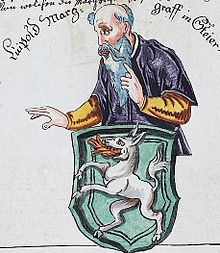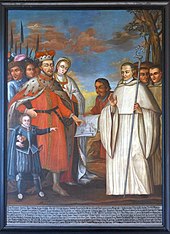
Styria is an Austrian state in southeastern Austria. With an area of 16,401 km2 (6,332 sq mi), Styria is the second largest province of Austria, after Lower Austria. Styria is bordered to the south by Slovenia, and clockwise, from the southwest, by the Austrian provinces Carinthia, Salzburg, Upper Austria, Lower Austria, and Burgenland. The state's capital is Graz.

Rudolf IV, also called Rudolf the Founder, was a scion of the House of Habsburg who ruled as duke of Austria, Styria and Carinthia from 1358, as well as count of Tyrol from 1363 and as the first duke of Carniola from 1364 until his death. After the Habsburgs received nothing from the decree of the Golden Bull in 1356, he gave order to draw up the "Privilegium Maius", a fake document to empower the Austrian rulers.

Steyr is a statutory city, located in the Austrian federal state of Upper Austria. It is the administrative capital, though not part of Steyr-Land District. Steyr is Austria's 12th most populated town and the 3rd largest city in Upper Austria.

Leopold III, known as Leopold the Good, was the Margrave of Austria from 1095 to his death in 1136. He was a member of the House of Babenberg. He was canonized on 6 January 1485 and became the patron saint of Austria, Lower Austria, Upper Austria and Vienna. His feast day is 15 November.
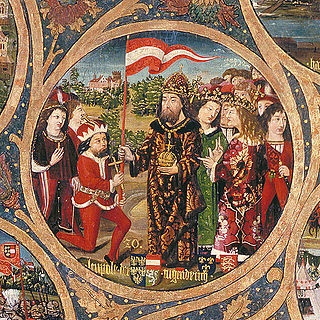
Leopold V, known as the Virtuous was a member of the House of Babenberg who reigned as Duke of Austria from 1177 and Duke of Styria within the Holy Roman Empire from 1192 until his death. The Georgenberg Pact resulted in Leopold being enfeoffed with Styria by Roman-German Emperor Frederick Barbarossa in 1193, which would lead to the eventual creation of modern Austria. Leopold was also known for his involvement in the Third Crusade where he fought in the Siege of Acre in 1191 and of his imprisonment of King Richard I in 1193 at Dürnstein Castle.
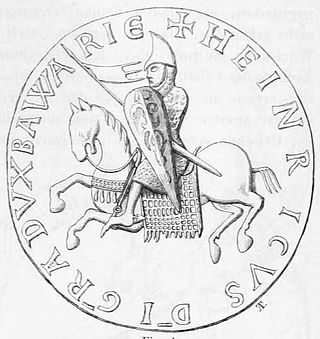
Henry II, called Jasomirgott, a member of the House of Babenberg, was Count Palatine of the Rhine from 1140 to 1141, Duke of Bavaria and Margrave of Austria from 1141 to 1156, and the first Duke of Austria from 1156 until his death.

Leopold, known as Leopold the Generous, was margrave of Austria from 1136, and duke of Bavaria from 1139 until his death in 1141.
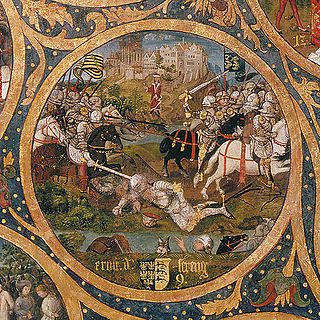
Ernest, known as Ernest the Brave, was the Margrave of Austria from 1055 to his death in 1075. He was a member of the House of Babenberg.
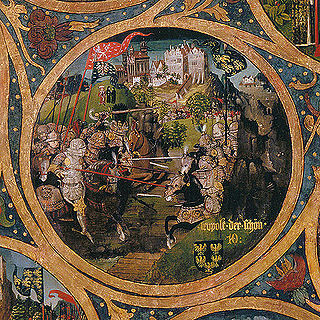
Leopold II, known as Leopold the Fair, a member of the House of Babenberg, was Margrave of Austria from 1075 until his death. A supporter of the Gregorian Reforms, he was one of the main opponents of the German king Henry IV during the Investiture Controversy.

Frederick I, known as Frederick the Catholic, was the Duke of Austria from 1195 to 1198. He was a member of the House of Babenberg.
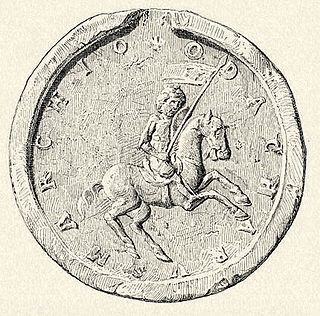
Ottokar IV, a member of the Otakar dynasty, was Margrave of Styria from 1164 and Duke from 1180, when Styria, previously a margraviate subordinated to the stem duchy of Bavaria, was raised to the status of an independent duchy.
The Otakars were a medieval dynasty ruling the Imperial March of Styria from 1056 to 1192.

Garsten Abbey is a former Benedictine monastery located in Garsten near Steyr in Upper Austria. Since 1851, the former monastery buildings have accommodated a prison.
Henry IV was Duke of Carinthia and Margrave of Verona from 1122 until his death. He was the first ruler of those territories from the Rhenish House of Sponheim.

Hartberg is a city in Styria, Austria, the capital of the Hartberg-Fürstenfeld District. As of 2014, it has a population of 6,449 in an area of 21.58 km2. About 68 km up the A2 is the large city of Graz.

The March of Styria, originally known as Carantanian march, was a southeastern frontier march of the Holy Roman Empire. It was broken off the larger March of Carinthia, itself a march of the Duchy of Bavaria, around 970 as a buffer zone against the Hungarian invasions. Under the overlordship of the Carinthian dukes from 976 onwards, the territory evolved to be called Styria, so named for the town of Steyr, then the residence of the Otakar margraves. It became an Imperial State in its own right, when the Otakars were elevated to Dukes of Styria in 1180.

The Duchy of Styria was a duchy located in modern-day southern Austria and northern Slovenia. It was a part of the Holy Roman Empire until its dissolution in 1806 and a Cisleithanian crown land of Austria-Hungary until its dissolution in 1918.

Rein Abbey is a Cistercian monastery in Rein near Gratwein, Styria, in Austria. Also known as the "Cradle of Styria", it is the oldest surviving Cistercian community in the world.
Since 2015 Gratwein-Straßengel is a market town in the Graz-Umgebung District of Styria, Austria. The town took effect as part of the Styria municipal structural reform, from the end of 2014 with the merging of the former municipalities Gratwein, Judendorf-Straßengel, Eisbach and Gschnaidt. The merger made the market town population to be the 6th-largest in Styria.

The Coat of arms of Styria is the historic coat of arms of the region of Styria, a federal state of Austria. It shows a white heraldic panther with red horns and claws breathing red fire on a green field. The shield is crowned with the ducal hat of Styria. The coat of arms is also used in several municipal arms of the state, including Graz and Steyr.
